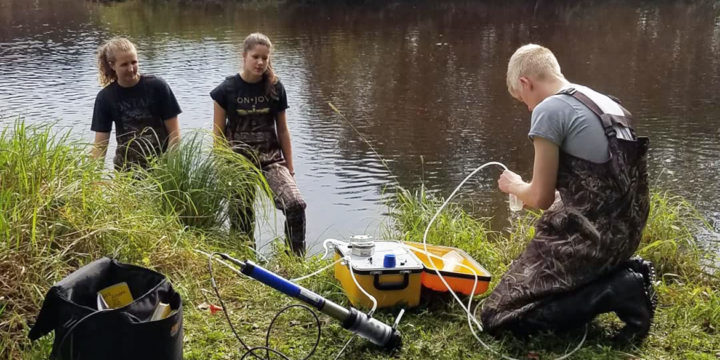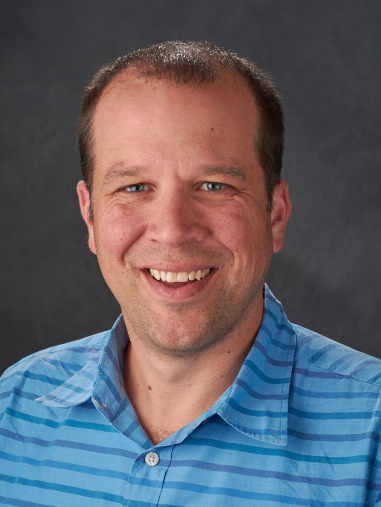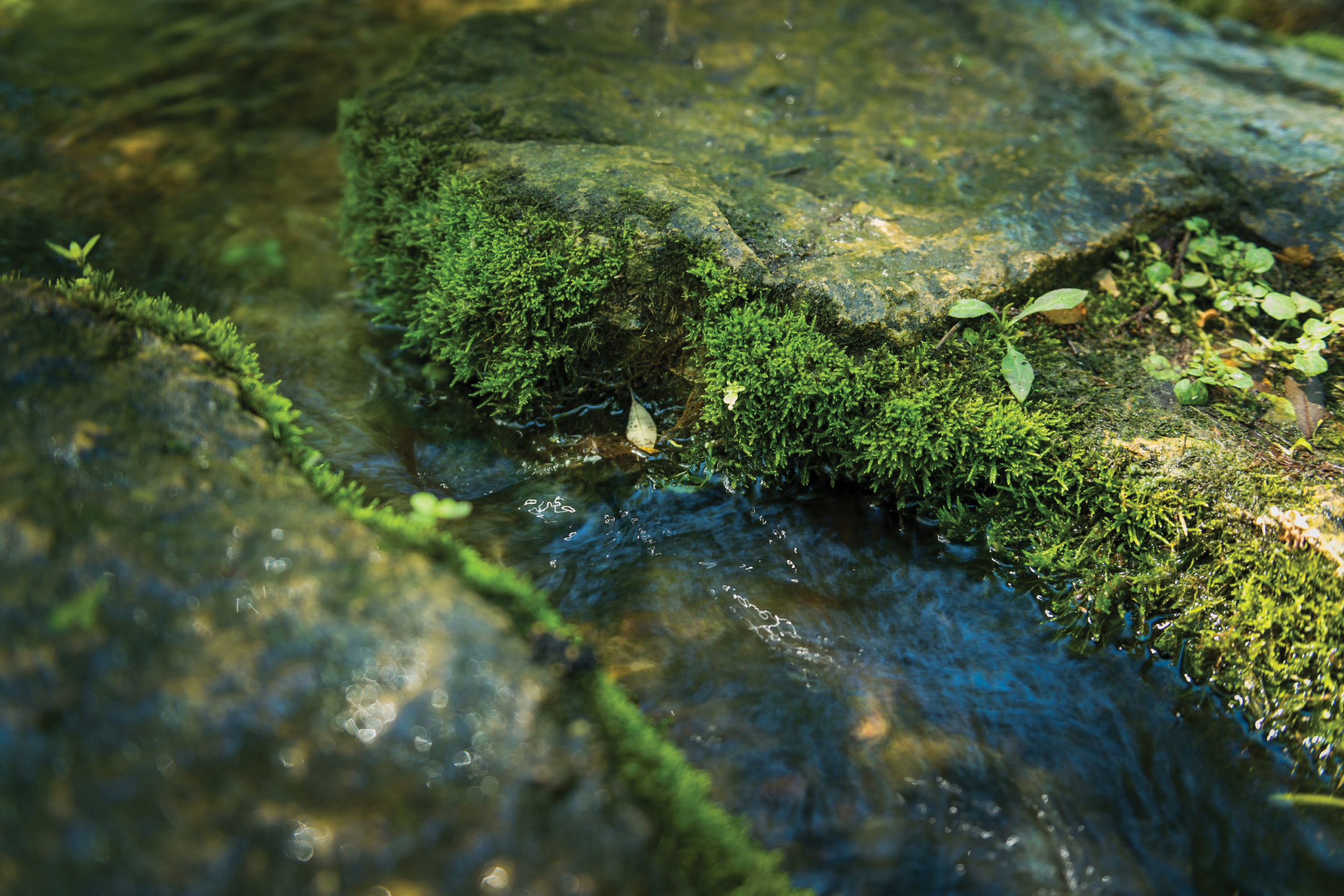March 27, 2020
By Jennifer A. Smith
Unsightly and potentially toxic algal blooms have grabbed headlines in Wisconsin. Such blooms are driven by excessive levels of phosphorus or other nutrients. This can result in eutrophication, a process in which oxygen becomes depleted from a body of water, causing ill effects for fish and other aquatic life—and harming human activities like tourism and commercial fishing.
While agricultural runoff is a frequent source of excess phosphorus, research funded by the University of Wisconsin Water Resources Institute (WRI) looks at a complex example in western Wisconsin where the answers are not so clear.
Researchers from the University of Wisconsin-Eau Claire are investigating the possibility that naturally occurring phosphorus deep in the aquifer is the driver behind elevated levels of phosphorus in both surface water and groundwater. The study is regional and includes a case study focused on the Mud Lake area in Barron County, about 45 miles north of Eau Claire.
The study’s principal investigators are Assistant Professor Sarah Vitale and Professor J. Brian Mahoney, both of the UW-Eau Claire geology department. They received funding in WRI’s 2019-20 cycle for the study assessing the source and mobility of phosphorus in the hydrologic system in western Wisconsin. Joining them as a collaborator is Anna Baker, a hydrologist with the U.S. Geological Survey’s Upper Midwest Water Science Center.
Five UW-Eau Claire geology majors are gaining valuable hands-on experience by assisting the research team with fieldwork, collecting and interpreting data, and giving presentations at professional meetings.
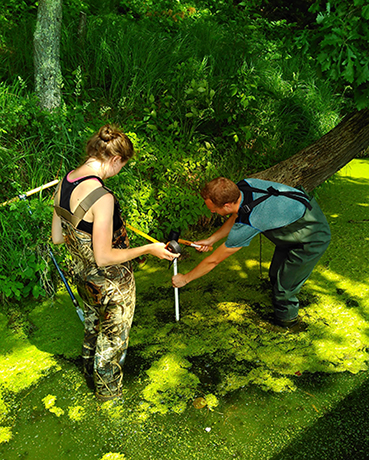
In fact, three of those undergraduates—Emily Finger, Evan Lundeen and Jacob Erickson— had a scientific poster accepted to the annual “Posters on the Hill” event hosted by the Council on Undergraduate Research in Washington, D.C. While the April 2020 event has since been canceled due to the COVID-19 pandemic, the students’ selection to present their research to members of Congress and their staffers remains a badge of honor.
And before state travel restrictions were in effect, Mahoney and some of his students presented their work at a “Research in the Rotunda” poster session in the Wisconsin State Capitol.
Building on earlier work to address “red flags”
While the WRI-funded portion of this project began in summer 2019, the work had its beginnings three years earlier.
Said Vitale of her colleague, Mahoney: “Brian initially started the foundations of this project in 2016. He started having students look at water quality in western Wisconsin because there was a lot of concern over what the increase in silica sand mining would do to water quality in this part of the state.”
At the time, Mahoney and his students analyzed water from a variety of sources, like municipal wells and streams. They were surprised to find a large amount of phosphorus in both groundwater and surface water in the area.
“That stood out as a really big red flag, because everybody says there’s not supposed to be phosphorus in groundwater. It’s just always been assumed it will absorb onto sediment surfaces—and so the fact that there were really high concentrations of phosphorus in groundwater led to this project’s current form,” said Vitale.
This sparked curiosity about possible natural sources of phosphorus and how that phosphorus might be moving through the system.
In 2018, Vitale and Mahoney began a case study investigating groundwater discharge into Mud Lake, a lake known to have eutrophication problems. “The way we wrote this [WRI] proposal was to help continue the investigation. It’s been able to fund a second season of investigation for Mud Lake, as well as continued investigation of regional water quality.”
Vitale and her collaborators plan to use the funding to draw conclusions about where naturally occurring phosphorus is coming from.
Summarized Vitale, “We hope to wrap up the regional investigation and to really constrain which aquifers seem to be the biggest problem. Where is phosphorus concentrated the most in different aquifers? And in these deeper aquifers, the phosphorus is probably sourced from the rock itself, so which rocks are the main contributors to that?”
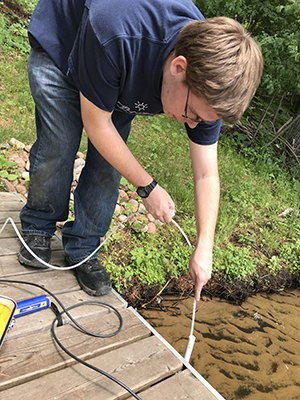
The team’s WRI funding runs through June 2020. Other funds supporting this work have come from UW-Eau Claire’s Office of Research and Sponsored Programs. In addition, backing from the UW System Water Research Fellowship Program has allowed the project to expand to Lake Altoona in Eau Claire County.
The team has also recently been awarded a fiscal year 2021 grant from the State of Wisconsin Groundwater Research and Monitoring Program (for “Source to sink evaluation of phosphorus in the hydrologic system in Wisconsin: Implications for lake eutrophication”).
Three experts, working together
Vitale, Mahoney and Baker all bring different areas of expertise to the study. Vitale is a hydrogeologist who specializes in aquifer flow characterization (how water moves through various types of geology). Mahoney brings a background in rock chemistry, and so his primary focus is on understanding what the chemistry of the geology looks like and the likelihood of its influencing the water quality.
Baker’s primary expertise is in phosphorus migration through sediment transport. Because phosphorus does migrate through sediment runoff and other surface processes, Baker is helping the team understand, in Vitale’s words, “What do we need to look at to understand which components of this might be the water side, and which components might be the sediment influence? Anna is bringing that nutrient-loading background.”
Last spring, Vitale shared some results from this project at the meeting of the American Water Resources Association—Wisconsin Section. As the research progress, findings are also being shared with key stakeholders like the Wisconsin Department of Natural Resources, U.S. Geological Survey, Wisconsin Geological and Natural History Survey, and organizations local to the Eau Claire area.

